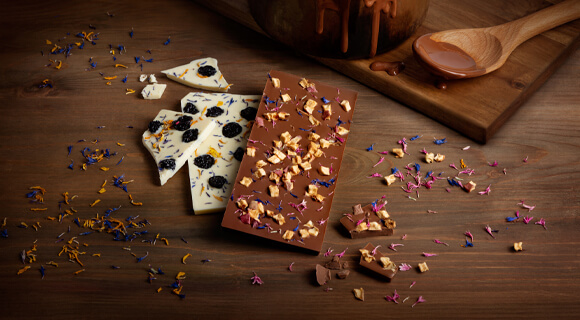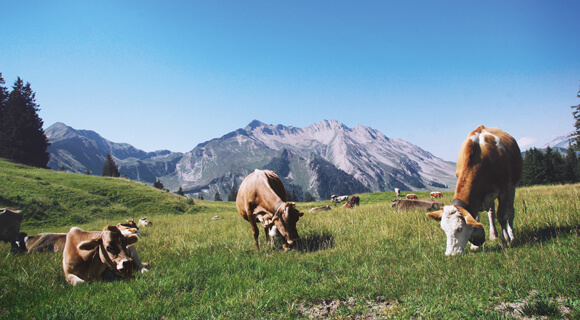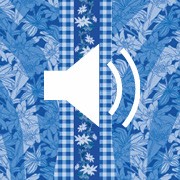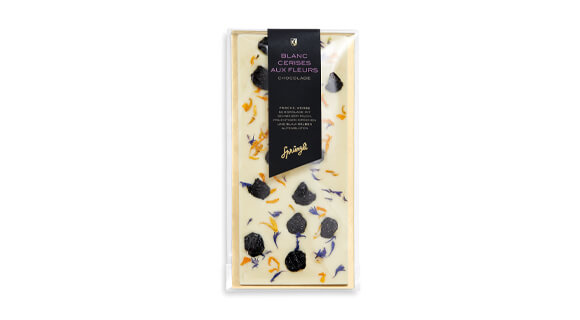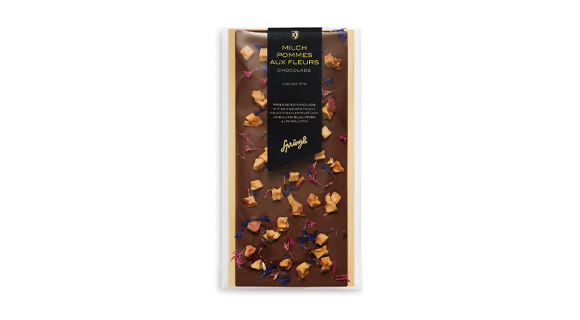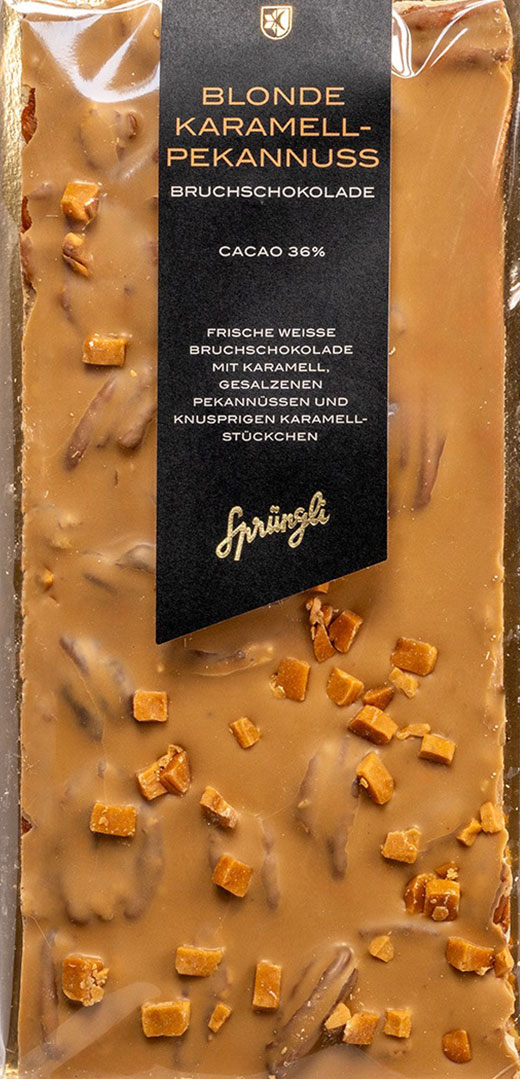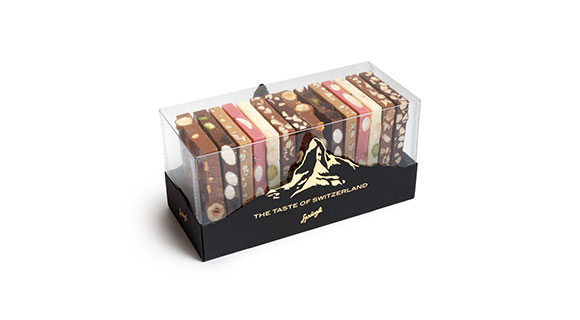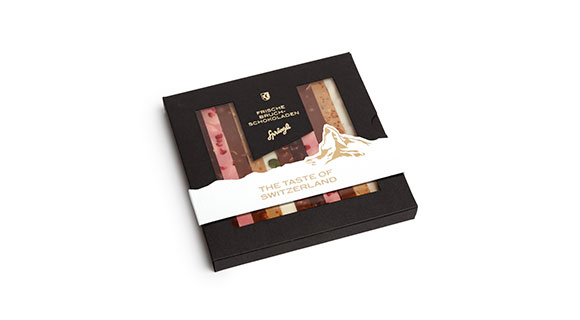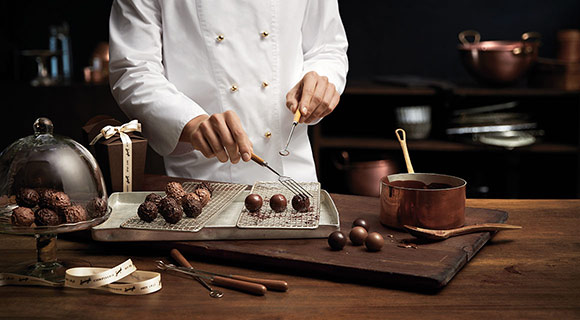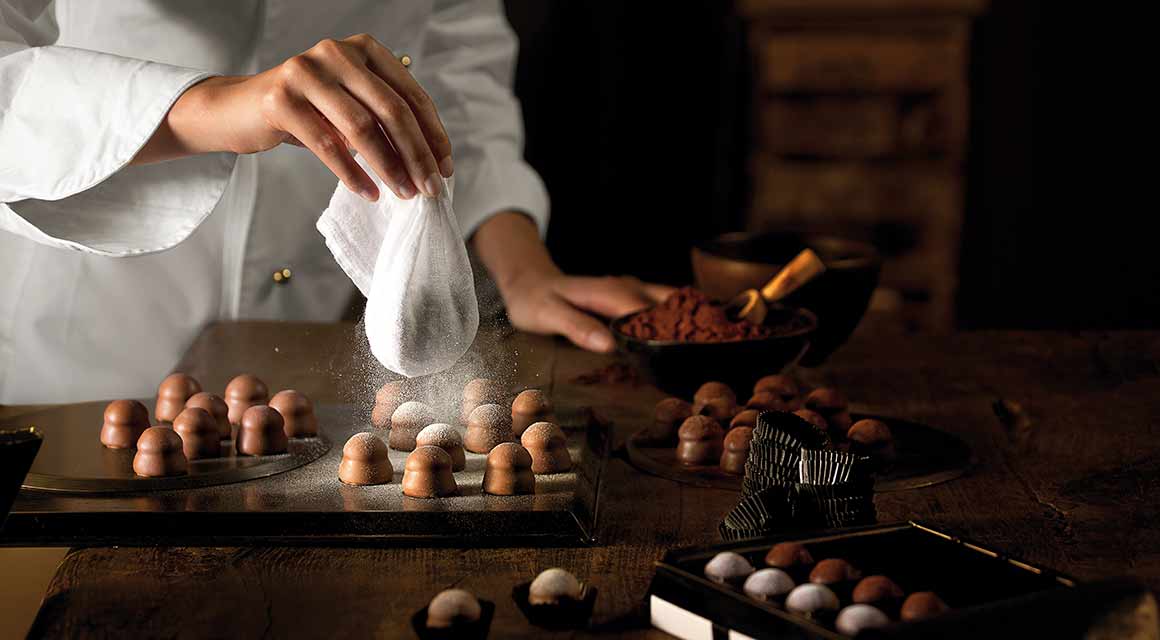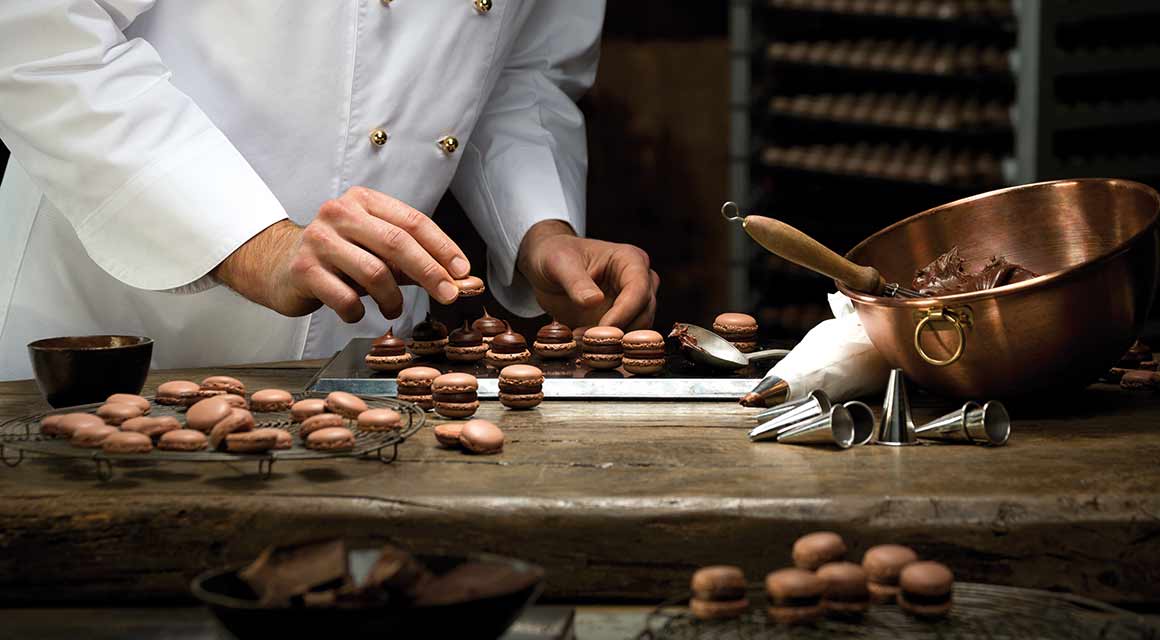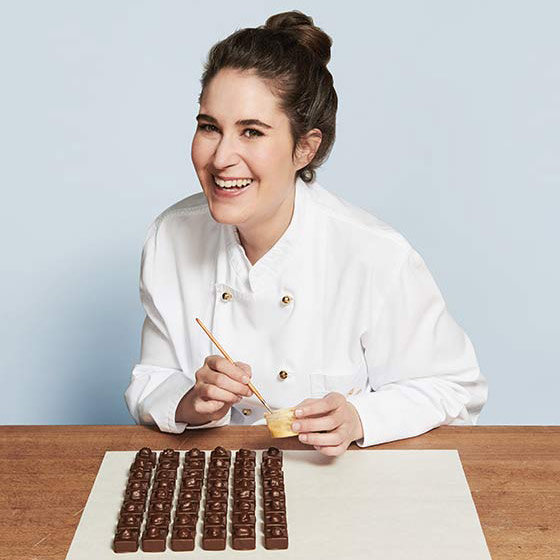Our chef chocolatier gives ‘short and sweet’ definitions of the most important terms from the world of chocolate. From grand cru and cru sauvage to conching and fine (flavour) cocoa – because it’s our passion.
Click on the relevant letter to find your search term faster:
Arriba cacao
Arriba cacao is an Ecuadorian fine cacao. The very old name ‘Arriba’ is derived from the place where the cacao originated, the Upper Amazon (arriba = above, on top). Arriba cacao has a distinctive taste that is characterised by smoky, spiced notes and a balanced fruit acidity. It is suited to very dark chocolate, such as our Grand Cru Noisette chocolate bars with 72% cacao, and our grand cru truffles.
Chocolate
There are three basic types of chocolate: dark, milk and white chocolate. The darker the chocolate, the more cocoa it contains and the more intense the characteristic cocoa flavour.
To our chocolate bars
Cacao fruit
Cacao fruit grows from the flowers of the cacao tree over a period of 5–6 months. They come in different shapes and colours. Depending on the type, they can weigh up to 1.5 kilograms and contain approximately 50 cacao seeds. These are nestled in a succulent white pulp that has a sweet, fresh taste. At peak ripeness, small-scale farmers carefully hand-pick the cacao fruit using a machete or hook-shaped knife.
Cacao tree
Growing up to 15 metres in height, the cacao tree is one of the smaller trees in the tropical forests of Central and South America. The shade of large trees provides the optimum conditions for growth, allowing cacao trees to live for up to 100 years. Only around 50 cacao fruits grow each year from a total of approximately 100,000 flowers. What is special about cacao trees is that they bear fruit all year round. Fruit at different stages of ripeness hang together on the same tree.
Cocoa
Cocoa is a dry matter produced after the fermentation and roasting of the cocoa beans. Besides the dry matter, these two processes also give rise to cocoa butter.
The fruit of the cocoa (or cacao) tree is the cocoa pod, inside which there are many cocoa beans. Cocoa as we know it is made from these beans.
Find out more
Cocoa butter
Cocoa butter is the fat of the cocoa bean and gives the chocolate its deliciously smooth-melting property and a firm ‘snap’. It is the cocoa butter that makes the chocolate firm when cold and soft when warm. The cocoa butter is produced after the fermentation and roasting of the cocoa bean.
Cocoa content
The cocoa content of a chocolate tells you how much cocoa has been used to make the chocolate. This includes the dry matter and the cocoa butter.
Conching
Conching is the process by which the bitter substances in the couverture dissipate under constant stirring. The longer the couverture is conched, the more delicately smooth it becomes.
Learn more about the processing
Couverture
Couverture is a chocolate with a higher percentage of cocoa butter. This enhances its quality and makes it slightly more fluid. The high fluidity of the couverture means that it is ideal for further processing into Sprüngli chocolate specialities.
Criollo cocoa
Criollo cocoa is a fine cocoa variety that is hardy bitter at all and only mildly acidic. The Criollo bean accounts for 3% of world production. Confiserie Sprüngli uses Criollo beans from Maracaibo in Venezuela, Madagascar, Bolivia and Arriba in Ecuador for its exquisite chocolate specialities.
Learn more about the coca varieties
Cru Sauvage
The Department of Beni, in the Bolivian Amazon wetlands, is home to the wild-growing fine cocoa variety. It thrives naturally scattered across forests and along rivers, and is harvested in the wild on a limited scale. Its uncommonly pure and intense aroma makes it a real rarity and premium-quality speciality.
Find out more
Dark Chocolate
Dark chocolate is chocolate with a cocoa content of 50% or more. No milk is used in dark chocolate, making it the chocolate of choice for lactose-sensitive or vegans. It has also been scientifically proven that the alkaloids contained in dark chocolate help to reduce stress and - enjoyed in moderation - can even increase mental and physical performance.
To our chocolate bars
Dipping
Pralines are coated by dipping them into a liquid such as couverture.
Learn more about the confectioner’s craft
Fermentation
Once the cocoa beans have been removed from the pod, they are fermented. Fermentation is a process that causes the beans to lose some of their natural bitterness. During this process, which takes several days, the cocoa bean develops the familiar chocolate flavours and aromas.
Learn more about the processing
Fine (or flavour) cocoa
Fine cocoa (alternatively: flavour cocoa) is characterised by its superb quality, its provenance and its unique character of intense aromatics. The three cocoa varieties from South America – Criollo, Trinitario and Arriba Nacional – are classified as pure fine cocoa. The rare and precious fine cocoa makes up only 15% or so of the world cocoa harvest. Confiserie Sprüngli uses fine cocoa from the world’s best growing regions in its chocolate specialities.
Find out more
Forastero cocoa
This cocoa is considered the originator of all cocoa varieties and delivers very good harvests thanks to its robustness. It accounts for some 80% of global cocoa cultivation. A typical characteristic of Forastero is its powerful cocoa flavour that is only slightly aromatic and can also be bitter or acidic. It is often referred to as consumer (or bulk) cocoa.
Ganache
A ganache is a smooth mixture of couverture with finest cream. Confiserie Sprüngli only uses the best chocolate and fresh Swiss cream for its ganache. A dark-chocolate ganache is often called truffle mass. It is used in classic Sprüngli truffles, pralines and cakes.
To our pralines and truffles
Gaufrette
A gaufrette is a small, filled wafer roll. Precursors to gaufrettes could be found in Switzerland as early as the 14th century. The idea of adding a sweet filling to the wafer rolls emerged at the start of the 20th century. Confiserie Sprüngli’s crispy gaufrettes are filled with premium chocolate and pieces of the finest Piedmont hazelnuts.
To our gaufrettes
Gianduja
Gianduja is a mixture of roasted, ground almonds or hazelnuts with liquid couverture and icing sugar. At Confiserie Sprüngli, it is used mainly for pralines.
To our pralines and truffles
Grand Cru
Grand cru is a quality label that indicates a single-variety selection of premium-quality cocoa beans. Grand cru cocoa is also distinguished by supreme quality, the world’s best provenances, meticulous processing, optimum harvesting time, lengthy conching and its exquisite character.
Confiserie Sprüngli uses this fine cocoa in its melt-in-the-mouth grand cru truffles and other chocolate specialities.
Find out more
Grand Cru Absolu
Grand Cru Absolu chocolate is made from just two ingredients, a true sign of its naturalness and quality. Sprüngli uses Bolivian single-origin cacao beans and the natural sweet juice from the cacao fruit to handcraft small batches of dark chocolate truffles and outstanding Luxemburgerli.
Find out more
Kakawa
The Olmecs began to grow the plant known in the local language of Nahuatl as ‘kakawa’ as early as 1500 BCE in the lowlands of the Gulf of Mexico. Over 1,000 years later, the Maya peoples inherited not only the knowledge about the plant’s cultivation but also the name ‘cacao’, which was originally pronounced ‘kakawa’.
Milk chocolate
The creamy flavour and delicate melt-in-the-mouth properties of milk chocolate make it one of the most popular chocolates. Premium quality milk chocolate is made from cacao, cocoa butter, milk and sugar. It’s thanks to the maximum freshness and quality that we are able to make our products without any preservatives. Depending on the cacao percentage and flavours, there’s also an indulgent variety of taste combinations to discover in milk chocolate. The flavour of milk chocolate is also refined with soja lecithin or natural vanilla. For our milk chocolates, we use exclusively Swiss milk that meets our animal farming and milk processing standards.
Nougatine
When making nougatine, sugar is first caramelised in a pan and then mixed with chopped almonds. The roasted flavour of the almonds lends the nut brittle its typical nougatine taste.
Pralines
Pralines are bite-sized confectionery works of art made of chocolate. Their filling can consist of different ingredients, giving the pralines their unique taste. From much-loved classics like our Number One to the Liliput pralines, Confiserie Sprüngli offers a very varied assortment of chocolate specialities.
To our pralines and truffles
Trinitario Cocoa
Trinitario cocoa is a relatively young variety compared to Criollo and Forastero cocoa. It is one of the fine (or flavour) cocoa varieties and combines the good disease resistance of Forastero consumer cocoa with the pleasant taste characteristics of Criollo. Trinitario cocoa has a powerful, aromatic cocoa flavour and only a slight acidity.
Learn more about the coca varieties
Truffes du Jour
Confiserie Sprüngli’s Truffes du Jour are the freshest truffles in the world – lovingly handmade daily to traditional Sprüngli recipes. Their heart of lusciously smooth-melting chocolate and fresh Swiss cream makes for an intensely creamy taste sensation. The spiky appearance and unique size lend the Truffes du Jour their exceptional character.
Find out more
Truffles
Truffles are small chocolate specialities with a gorgeously smooth-melting heart of finest ganache that may also be enhanced with various ingredients. Driven by a passion for perfection, we prepare truffles by hand fresh daily with a great deal of love.
To our pralines and truffles
Vanilla
Vanilla is the undisputed ‘queen of the spices’. To ensure the highest quality, we only use natural vanilla from countries such as Madagascar, La Réunion and other carefully selected growing regions to refine our products. Discover this delicate flavour in our vanilla ice cream, our cream slices, our Truffes du Jour and in our dark Sprüngli chocolate.
Learn more about our ingredients
White chocolate
White chocolate doesn’t contain any pure cacao. It’s made from cocoa butter, sugar and milk. White chocolate contains at least 20% cocoa butter and usually has more sugar than milk or dark chocolate. The white colour is due to the lack of cacao content. That’s why we value the finest natural ingredients all the more in our white chocolate. You can taste their balanced flavours in our white chocolate bar, which melts in your mouth perfectly.
Wild harvesting
Wild harvesting is the term for gathering wild-growing, single-variety cacao beans. These are not cultivated in the conventional way, but are naturally dispersed in forests to flourish, and are harvested in the wild over a limited period. Their uncommonly pure and intense aroma makes them a true rarity and high-quality speciality.
To our pralines and truffles
Xocolatl
Xocolatl is the linguistic origin of the word chocolate. It refers to the bitter drink of the Mayas and Aztecs made from roasted and ground cocoa beans and water, which was called Xocolatl (from xoco "bitter" and atl "water") in Aztec.
